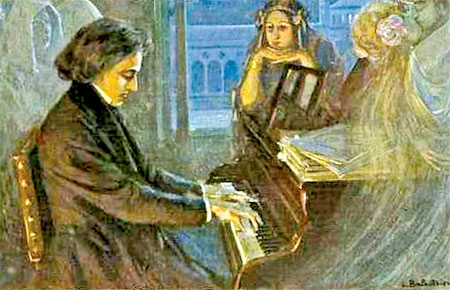Chopin and life in Paris
While in Paris, , Frederic Chopin found his delicate style didn't
always enthrall the larger concert audiences, who had been exposed to
the works of Franz Schubert and Ludwig Van Beethoven.
 A fortuitous introduction to the Rothschild family opened new doors,
however, and Chopin soon found employment in the great parlours of Paris
as both recitalist and teacher. A fortuitous introduction to the Rothschild family opened new doors,
however, and Chopin soon found employment in the great parlours of Paris
as both recitalist and teacher.
His increased income allowed him to live well and compose such pieces
as Nocturnes of Op. 9 and 15, the Scherzo in B-flat minor, Op. 31 and
the Sonata in B-flat minor, Op. 35.
Relationship with George Sand
Though Chopin had had youthful love affairs and was at one time
engaged, none of his relationships lasted more than a year. In 1838 he
began a love affair with French novelist Aurore Dedevant, aka, George
Sand. The couple spent a harsh winter on the island of Majorca, south of
France, where Chopin became ill. In March 1839, Sand realised that he
needed medical attention and took him to Marseille, where he was
diagnosed with consumption (tuberculosis). There, a skilled physician
helped him recover.
In May 1839, Frederic Chopin and George Sand settled in south of
Paris in Nohant, Sand's country home.
The next seven years proved to be the happiest and most productive
period of Chopin's life.
He steadily composed a series of masterpieces, including the B Minor
Sonata, theOpus 55 Nocturnes and the Opus 56 Mazurkas.
The growing demand for his new works and his greater understanding of
the publishing business also brought increased income and provided
Chopin an elegant lifestyle.
Final years and death
 By the mid-1840s, both Chopin's health and his relationship with
George Sand were deteriorating. His behaviour had become erratic,
possibly due to an undiagnosed form of epilepsy. The affair ended in
1848 after, among other things, Sand's unflattering portrayal of their
relationship in her 1846 novel Lucrezia Floriani. At the end, both
parties were too proud to reconcil and Chopin's spirit and health were
broken. By the mid-1840s, both Chopin's health and his relationship with
George Sand were deteriorating. His behaviour had become erratic,
possibly due to an undiagnosed form of epilepsy. The affair ended in
1848 after, among other things, Sand's unflattering portrayal of their
relationship in her 1846 novel Lucrezia Floriani. At the end, both
parties were too proud to reconcil and Chopin's spirit and health were
broken.
He made an extended tour to the British Isles, where he struggled
under an exhausting schedule, making his last public appearance on
November 16, 1848. He then returned to Paris, where he died on October
17, 1849 at 38.
His body was buried at Pčre Lachaise cemetery, but his heart was
interred at a church in Warsaw, near the place of his birth.
The Chopin Family Parlour (Polish: Salonik Chopinów) is a branch of
the Fryderyk Chopin Museum.
It is in the south annex of the Czapski Palace at 5 Krakowskie
Przedmiescie in Warsaw, Poland. It is the largest room of the former
Chopin family apartment where Frédéric Chopin lived with his parents and
sisters until he left Poland in 1830.
The family moved to the Czapski Palace (then called the Krasinski
Palace) from a Warsaw University building, across the street, in June
1827, just a few weeks after the death of Frédéric's youngest sister,
Emilia. Her death was the reason for the move, as it was emotionally
difficult for the family to remain in the apartment that had witnessed
her decline and death.
The new apartment comprised two levels. The family lived in a large
second-floor flat, and the garret served as a boarding house for male
students.
The latter was run by Frédéric's father, Nicolas Chopin. In a letter
to his friend Tytus Wojciechowski dated 27 December 1828, Frédéric said
that one of the former boarding-school rooms had been turned into a
study for him.It contained only a desk and piano; it has not been
reconstructed.

It was in the Czapski (Krasinski) Palace that Frédéric Chopin
composed and first played for family and friends some of his most
important youthful works, including Piano Concerto No. 1 in E minor, Op.
11, and Piano Concerto No. 2 in F minor, Op. 21. Frequent visitors
included Józef Elsner, Samuel Linde, Juliusz Kolberg, Kajetan Kozmian,
Julian Ursyn Niemcewicz, and Stefan Witwicki.
On November 2, 1930 a commemorative plaque was unveiled between the
windows of the annexe second floor (viewed from the Krakowskie
Przedmiescie side).
The inscription in Polish reads: Frédéric Chopin lived and composed
in this house before he left Warsaw forever in 1830.
The CzapskiPalace was destroyed during World War II and reconstructed
in 1948-59.
The little museum occupies just one room on the second floor of the
building that now houses the Graphics Department of the Academy of Fine
Arts in Warsaw - The interior was designed by Barbara Brukalska, based
on an 1832 drawing by Antoni Kolberg. None of the apartment's original
furnishings have survived.
-Internet |

